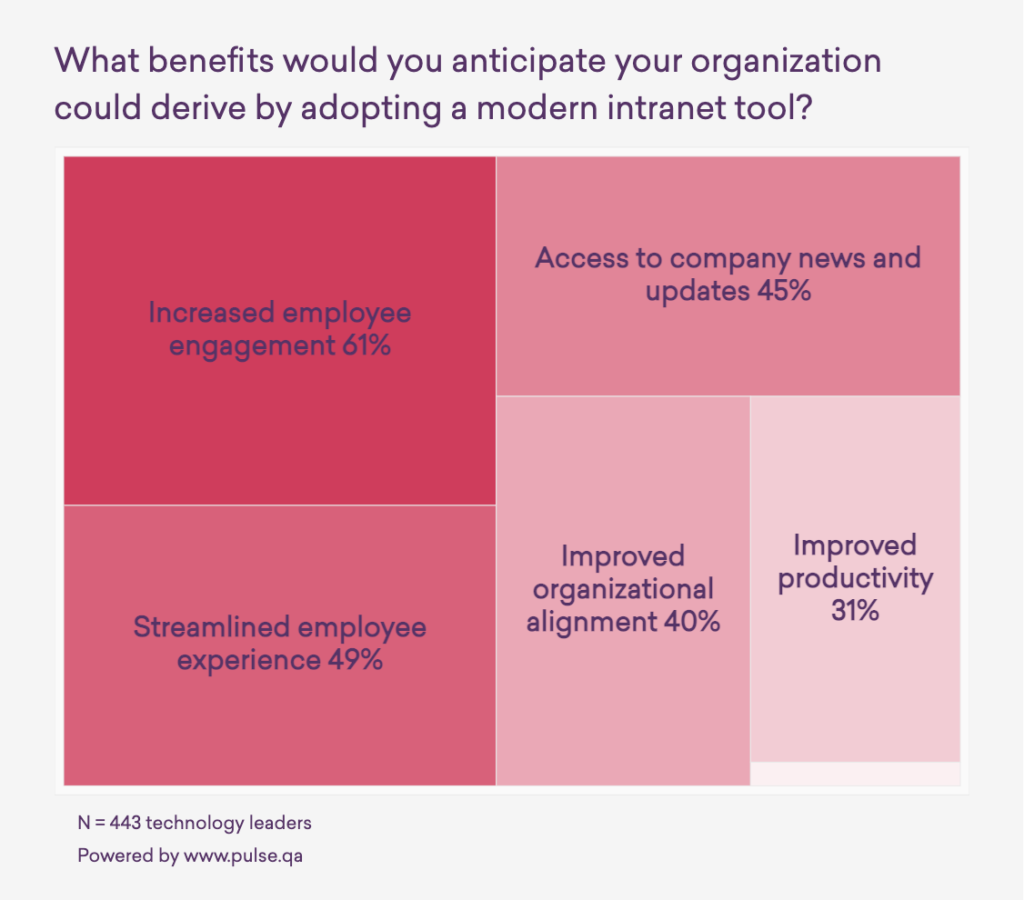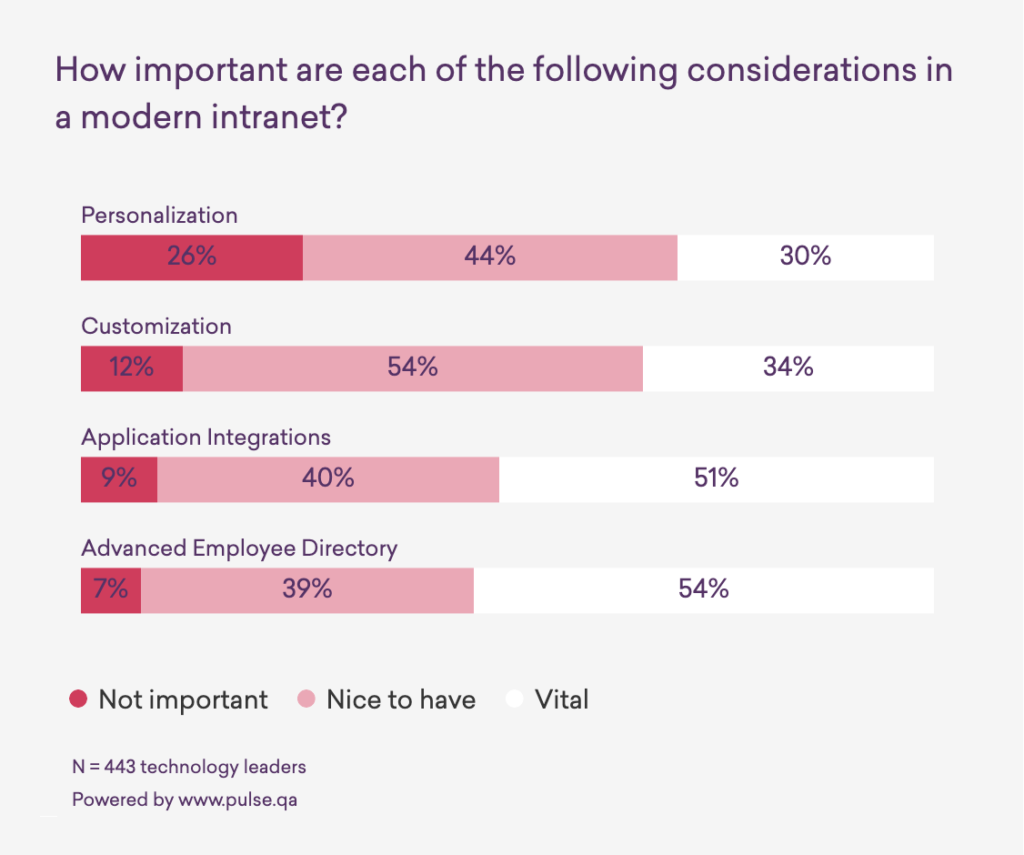In partnership with Pulse, a leader in social research, Firstup conducted an in-depth exploration of the modern intranet through the insights of HR, IT, and communications professionals, highlighting essential intranet best practices for today’s workforce. This collaboration highlights the limitations of outdated platforms and identifies the essential features that today’s workforce requires to thrive.

Get access to the full report to learn what feature 80% of respondents believe to be the most important in a modern intranet solution
The workplace has undergone significant transformation in the past year, creating an urgent demand for improved employee experiences. As traditional intranet solutions struggle to engage all employees of a digital workplace effectively, organizational leaders recognize the necessity of adopting modern intranet solutions that keep employees engaged and fosters collaboration.
In this article, we present 14 intranet best practices to ensure success with your company.
#1. Optimize the reach of your communications using mobile devices
To effectively engage deskless and remote employees, it’s essential to deliver communications directly to the devices they prefer. Many employees may not have regular access to a desktop computer, yet they likely carry mobile devices that can facilitate timely communication. Relying solely on traditional, corporate intranet postings will not suffice in today’s work environment; your communications must meet employees where they are.
Adopting a multichannel approach that prioritizes mobile accessibility is key to maximizing the reach of your messaging. This strategy enhances employee engagement by providing multiple touchpoints for information dissemination. Here are several channels to consider:
Instant messaging:
Enhance connectivity and foster communication among teams by leveraging real-time messaging tools.
Newsfeed feature:
Deliver top-level company updates that remote workers can quickly digest, ensuring they remain informed about important developments.
Mobile app:
Implement a dedicated mobile application that enables deskless and frontline workers to access essential information anytime, anywhere.
Video calling:
Utilize video conferencing to create a more personal connection, helping employees feel valued and seen, regardless of their physical location.
By diversifying your communication strategy to meet these intranet best practices, you can significantly boost engagement levels and ensure your workforce remains connected and informed about organizational objectives. A mobile-first approach is particularly effective in reaching frontline workers, enabling them to stay aligned with company goals and initiatives.
#2. Design your intranet with usability in mind
Creating a user-friendly employee intranet is one of the key intranet best practices for ensuring employees can efficiently access the information and tools they need. Given that the intranet team is responsible for uploading, creating, and managing the platform, it’s easy to become so engrossed in functionality that you overlook usability from the end-user perspective.
To build an effective intranet platform for employee engagement, you must regularly ask: Why are employees using the intranet? Are they seeking collaboration tools, trying to access important documents, or filling out necessary forms?
Understanding these motivations is essential for crafting a valuable resource. Here are key features to consider when designing a successful intranet platform that employees interact with:
Integration functionality: Ensure your intranet integrates seamlessly with essential tools used across the organization. Automating updates to the intranet provides a centralized hub for information without overwhelming users. (More on this later.)
Robust search functionality: A powerful intranet search functionality is crucial for user-friendliness. Employees should quickly locate information, from company policies to specific documents. Invest in advanced search capabilities with filters, tagging, and relevance ranking to enhance efficiency.
Clear navigation structure: Create a straightforward navigation system with top-level categories and subcategories that meet team needs. Use short, descriptive labels to help users find relevant sections easily.
Mobile optimization: As remote work remains standard, ensure your employee intranet is mobile-friendly. A responsive design allows easy access from any device, promoting continuous engagement regardless of location.
User-centric design: Regularly collect feedback from employees to enhance the intranet experience. Conduct usability testing to identify pain points and ensure the design evolves with employee needs and preferences.
Hyper-personalized comms for every employee
#3. Measure how well your intranet contributes to broader business objectives
Intranet software should do more than just serve as a platform for internal communications; it must actively contribute to achieving broader business objectives. To maximize its impact, organizations must ask: What role does the intranet play in fulfilling strategic goals, and is it aligned to support those objectives?

To understand the effectiveness of your intranet, it’s essential to measure your internal communications performance, a critical component of intranet best practices. This involves establishing clear metrics that reflect how well the intranet serves its purpose. Consider the following approaches:
Define Key Performance Indicators (KPIs): Identify specific metrics to assess your intranet’s performance, such as user engagement rates, content update frequency, employee feedback scores, and active user counts. Tracking intranet adoption rates can help gauge overall utilization across the organization.
Analyze communication metrics: Regularly evaluate how employees engage with intranet content. Are they accessing important documents, participating in discussions, or using collaborative tools? This analysis uncovers effective strategies and areas needing improvement.
Gather employee feedback: Solicit employee input on their intranet experience through surveys or focus groups. Understanding their needs and challenges adds qualitative insights to your quantitative data, providing a comprehensive view of intranet effectiveness.
Align with business goals: Ensure the metrics you track align with your organization’s strategic objectives. For instance, if boosting employee engagement is a priority, monitor participation in intranet initiatives and communication campaigns aimed at fostering collaboration.
Create actionable insights: Consistently track and analyze these metrics to identify trends that inform your intranet strategy. Use this data for decisions on content creation, communication methods, and platform enhancements. Regularly report these insights to demonstrate the intranet’s value to stakeholders, securing ongoing support for its development.
By establishing a framework for assessing performance, you can optimize your company intranet to foster a more engaged and informed workforce.
#4. Leverage your intranet to encourage a bidirectional dialogue
Intranets are often viewed as one-way communication channels, primarily used to distribute information from the organization to employees. However, this approach can lead to disengagement and a disconnect among the workforce. To maximize your intranet’s potential, it’s crucial to transform it into a platform that fosters bidirectional dialogue, aligning with established intranet best practices.
Create interactive spaces: Implement regular town hall meetings, live Q&A sessions, forums, or discussion boards within your intranet to provide designated areas for employees to engage in meaningful conversations, share insights, and exchange ideas, enriching the intranet’s content and fostering a sense of community.
Encourage profile creation: Allow employees to create and maintain profiles similar to those on professional networking sites. Including details about their roles, expertise, and interests helps employees connect with colleagues across the organization, facilitating collaboration and knowledge sharing.
Incorporate feedback mechanisms: Integrate tools like polls and surveys within the intranet, allowing employees to express opinions on company initiatives and share suggestions for improvement. This demonstrates that leadership values employee input and is willing to act on it, strengthening trust and transparency within the organization.
Promote an open dialogue: Regularly encourage employees to engage in discussions and share feedback, ensuring the intranet becomes a vibrant platform for two-way communication. This engagement enhances the employee experience while cultivating a more connected and collaborative workplace.
#5. Use your intranet to create a strong company culture
As the digital workplace continues to evolve, your intranet should act as a vital tool for communicating your organization’s mission and values. Here are key ways your intranet can help foster a strong company culture while achieving intranet best practices.
Communicate core values:
Use the intranet to share and reinforce your organizational brand and purpose, ensuring all employees understand and connect with the company’s mission.
Streamline onboarding:
Provide new hires with access to essential resources and information about company culture, helping them integrate smoothly into the organization from day one.
Encourage active participation:
Create spaces for employees to share their thoughts and ideas, fostering a sense of ownership and involvement in shaping the company culture.
Support remote engagement:
Use the intranet to maintain connections among dispersed teams, offering regular updates, virtual events, and interactive features to ensure everyone feels included.
Employees should feel comfortable building and contributing to your company culture through a vibrant dialogue on your intranet. Make resources available that empower employees to build a strong company culture.
Help your organizations better engage and support all your people.
#6. Decentralize your communications
Decentralized communication is an emerging trend that can significantly enhance internal communications and is one of the crucial intranet best practices for fostering employee engagement. Rather than maintaining strict control over every message shared on the intranet, empowering employees to take ownership of the platform fosters a sense of community and encourages authentic engagement.
Empower employee contributions: Encourage staff from all departments to share content and insights on the intranet. This diversifies information and allows employees to showcase their expertise, enriching the overall communication landscape.
Establish clear guidelines: Set up a management system as part of your strategic planning to define approval guidelines for content. This ensures posts align with the company’s brand and messaging standards while allowing diverse voices and viewpoints.
Foster a culture of trust: Encourage open communication and information sharing to build a culture of trust. When employees feel valued and heard, they are more likely to engage with the intranet and contribute meaningfully to discussions.
Enhance relatability and relevance: A decentralized approach results in more authentic, personalized content. Employees connect better with messages that reflect their experiences, driving higher engagement and participation.
Utilize collaborative tools: Implement collaborative tools within the intranet that enable easy interaction, feedback, and resource sharing among employees. This fosters dynamic communication and encourages continuous dialogue among team members.
Ultimately, an intranet is created to enable employees to do their jobs. Decentralizing your intranet will help create authentic, personalized, and relatable content.
#7. Enhance your intranet with an AI assistant for a seamless experience
Integrating AI-powered assistants into your intranet can significantly elevate the user experience and streamline operations. These intelligent tools serve as personal guides for employees, facilitating easy navigation and ensuring they find the information they need quickly.
Key benefits of incorporating an AI assistant include:
Personalized guidance: AI assistants provide tailored recommendations based on individual preferences and roles, helping employees access relevant content effortlessly.
Efficient information retrieval: Quickly direct users to the most pertinent resources, reducing the time spent searching for information.
24/7 availability: AI assistants can answer common questions at any time, ensuring employees have support whenever they need it.
Enhanced engagement: By making the intranet more intuitive and accessible, AI assistants encourage employees to interact more fully with the platform, leading to increased usage and connection to company resources.
Continuous improvement: The AI can gather insights on employee interactions, providing valuable data to enhance future content and user experience.
By leveraging AI technology, organizations can transform their intranet into a dynamic, user-friendly environment that promotes efficiency.
Download the Pulse report to see how your peers rank content personalization and customization when evaluating modern intranet solutions.
An intranet should be a place for dialogue between employer and employee, instead of a place that workers only go to consume information rather than participating.
#8. Create highly engaging content
To capture your employees’ attention and foster a strong connection with your intranet, focus on intranet best practices that prioritize real value for the workforce. The way we consume content has evolved, and your intranet should adapt to these changes by offering diverse, engaging, and relevant material.
Prioritize user-centric content: Shift from top-down messaging to user-centric content that promotes participation and interaction. Include employee spotlights, success stories, and collaborative projects to highlight team contributions across the organization.
Utilize various content formats: Recognize that employees engage with different content types. Incorporate videos, podcasts, infographics, and interactive polls to cater to diverse preferences and keep content fresh and engaging.
Encourage employee contributions: Allow employees to share content and insights while participating in discussions. This enhances authenticity and fosters a sense of ownership, leading to increased engagement with the intranet.
Facilitate dialogue and feedback: Transform your intranet into a platform for dialogue between employees and leadership. Encourage comments, questions, and feedback on posted content, creating an interactive environment that builds trust and strengthens relationships.
Make content relevant and timely: Ensure intranet content addresses current topics, initiatives, and updates. Highlighting key projects or company news keeps employees informed and engaged, fostering transparency and open communication.
Promote continuous learning and development: Use the intranet as a hub for professional growth by providing access to training resources, webinars, and development programs. This empowers employees to enhance their skills while reinforcing a commitment to their personal and professional growth.
#9. Empower employees to share and contribute content
Encouraging employees to contribute content significantly enhances engagement on your intranet. By establishing a platform for sharing articles, success stories, and best practices, organizations cultivate a sense of ownership and pride among staff. Crowdsourcing content diversifies the available information and showcases the varied perspectives within the organization, enriching the overall knowledge base.
This collaborative approach fosters a deeper connection to the company’s mission and makes employees feel valued for their contributions. When employees see their insights and achievements recognized, it boosts morale and encourages further participation.
Additionally, consistently publishing employee-generated content keeps the intranet dynamic and relevant, ensuring users return regularly for fresh insights and updates.
#10. Make your intranet content easy to find and searchable
An effective intranet serves as a vital resource for employees, providing access to essential information, facilitating communication, and streamlining workflows. However, many traditional intranets suffer from outdated structures that hinder users from easily locating the information they need.
To enhance the usability of your intranet, prioritize the following strategies for making content easy to find and searchable:
- Implement advanced search functionality: A robust search feature is essential for enhancing user experience. Invest in advanced capabilities that allow employees to quickly locate documents and policies. Features like keyword search, filters, and predictive text can significantly improve the search experience.
- Organize content logically: Structure intranet content in a clear and intuitive manner. Use categories and subcategories that reflect typical employee search behaviors, reducing navigation time through excessive pages and folders.
- Utilize tags and metadata: Implement tagging and metadata to enhance content discoverability. By tagging documents with relevant keywords, employees can easily find information through search queries, streamlining the search process and improving content organization.
- Maintain an updated knowledge base: Regularly review and refresh intranet content to keep it relevant and accessible. An outdated knowledge base can frustrate users and waste time. Encourage employees to contribute new resources and archive obsolete materials.
- Create a centralized repository: Use the intranet as a central hub for all company files, documents, and communications. This consolidation allows employees to access necessary information in one location, minimizing the risk of lost or hard-to-find resources.
- Enable easy access to historical content: Ensure that historical content is easily searchable within the intranet. Employees should be able to find past posts and resources without navigating cumbersome archives, allowing them to leverage historical information for current decision-making.
By making your company intranet content easy to find and searchable, you empower employees to efficiently access the information they need, ultimately enhancing productivity and improving the overall employee experience.
Download the free report for the latest intranet insights from IT and Comms leadership.
#11. Make it easy to sign into your digital workspace
Simplifying the login process to your intranet is crucial for encouraging regular use. Implementing single sign-on (SSO) solutions can reduce friction and streamline access, allowing employees to connect quickly and efficiently. A straightforward login experience minimizes barriers, encouraging employees to engage more frequently with the platform. Additionally, ensuring that the sign-in process is secure yet convenient enhances user trust and satisfaction.
By prioritizing easy access, you enable employees to focus on utilizing the intranet for collaboration and communication, rather than struggling with cumbersome authentication processes.
#12. Create personalized, relevant, and targeted content

To effectively engage employees, it’s crucial to deliver content tailored to their specific needs. Personalizing communication ensures that each employee receives information that resonates, fostering a deeper connection to the organization and enhancing overall engagement.
One effective approach is to separate your workforce into distinct audience segments based on factors such as location, job title, and tenure. For example, frontline workers who frequently use the company app may benefit from in-app messaging focused on their immediate concerns, while office staff might prefer email updates. This targeted approach allows you to address the unique preferences of different employee groups, making communications more impactful.
Additionally, customize intranet homepages to reflect individual employee needs. By providing personalized homepages based on language, department, or role, you create a tailored user experience. This level of personalization increases the likelihood of employee engagement and encourages return visits to the intranet as a trusted information source.
Consider incorporating features that let employees select content preferences or follow specific topics of interest. Empowering employees to curate their information feeds promotes a sense of ownership and investment in the intranet, leading to higher participation and interaction.
Ultimately, the goal is to make the intranet a valuable tool for every employee, consistently delivering relevant content that enhances their experience within the organization. By prioritizing personalized, relevant, and targeted content, you cultivate a culture of engagement that keeps employees connected and informed.
#13. Offer rewards and employee recognition they’ll remember
Utilizing your intranet to recognize and reward employee achievements is essential for cultivating a positive company culture. Public acknowledgment through the platform can significantly boost morale and motivate employees to strive for excellence. Recognition can take many forms, from highlighting individual accomplishments in a dedicated section to celebrating team successes through announcements or newsletters.
By making employee recognition visible and accessible, you foster a sense of belonging and reinforce the behaviors and values that align with your organization’s goals. An effective rewards program can enhance engagement and retention, encouraging employees to remain committed to their roles.
#14. Integrate communications channels on a workforce communications platform
To maximize the effectiveness of your intranet, integrating various official internal communications channels into a cohesive workforce communications platform is essential. While refreshing your intranet is valuable, a truly optimized approach ensures that all communications are streamlined and accessible across multiple formats, catering to diverse employee preferences.
In today’s work environment, employees engage with information through various channels. To maintain their interest and ensure they receive critical updates, it’s important to deliver content via their preferred communication methods.
A unified workforce communications platform allows you to post content directly across all channels, ensuring that your messages reach employees wherever they are and however they choose to engage.
By centralizing communication efforts, you create a seamless experience that enhances employee engagement. Employees can access important information in real time, without having to navigate through multiple platforms or risk missing essential updates. This approach simplifies communication for your workforce and reinforces a consistent company brand voice and message across all interactions.
In addition, integrating channels fosters collaboration and connection among employees, regardless of their location or role within the organization. This capability is especially crucial for remote and deskless workers, who may rely more heavily on mobile or alternative communication tools to stay informed and engaged.
Leveraging a modern intranet solution to integrate your communications channels is a strategic move that enhances visibility, engagement, and collaboration throughout your organization.
Enhancing your intranet strategy
Implementing effective intranet best practices is crucial for fostering a thriving digital workplace. By prioritizing elements such as user engagement, promoting two-way communication, and ensuring easy access to relevant content, organizations can create an intranet that not only enhances employee experience but also drives overall productivity. As the workplace continues to evolve, investing in a modern intranet solution becomes increasingly essential.
To discover how Firstup can help you implement these best practices and transform your digital workplace, visit Firstup.io today. Empower your workforce with a communication platform that meets their needs and adapts to the future of work.
Download PDF








